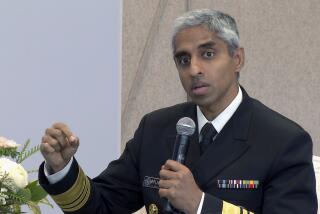U.S. Says Mammograms Help, and That’s Final
- Share via
WASHINGTON — Seeking to put to rest a growing controversy, a federal health task force declared Thursday that mammograms remain an effective cancer-detection tool and for the first time recommended the procedure every year or two for women in their 40s.
“Our bottom line is that mammography reduces deaths from breast cancer,” Janet Allan, vice chairwoman of the U.S. Preventive Services Task Force, said at a news conference. The task force--an independent panel of medical experts--advises the Department of Health and Human Services on the effectiveness of clinical procedures.
HHS Secretary Tommy G. Thompson called the results a “powerful message” to American women, who were administered about 30 million mammograms last year.
The report follows the publication of European studies concluding that there was no clinical proof the sometimes-painful exams have any benefit in preventing cancer deaths. Each year about 190,000 women in the United States are diagnosed with breast cancer; more than 40,000 die.
Doubts raised by researchers in Denmark, since echoed by some advisors to the National Cancer Institute, have led to widespread confusion about the procedure--confusion that U.S. health officials say is unwarranted.
Thursday’s recommendation marks the second time in a month that women have been urged to continue getting the X-rays of the breasts. A study published Feb. 2 in the Lancet, a prestigious medical journal, reinforced the value of the screening.
The task force has twice before spoken out on the value of mammography, which involves flattening the breast as much as possible between two metal plates and taking X-rays from two angles.
Its two earlier statements, issued in 1989 and 1996, urged women older than 50 to get regular mammograms, and the new results concluded that women ages 50 to 69 remain the most likely to benefit from regular screening.
But because, as Allan said, “the evidence supports the results of reduced mortality,” the task force expanded its recommendation to include women 40 to 49, a group already urged by major medical associations to seek regular mammograms.
The task force, which looked at the same clinical studies reviewed by the Danes, determined there is “fair evidence” that regular mammograms can reduce by 20% the chances of dying from breast cancer.
Allan said the task force disagreed with the Danish researchers’ conclusion that there were fatal flaws in the clinical studies--largely conducted in the 1970s and 1980s--backing mammograms. The panel acknowledged that the studies did have problems but said any such flaws did not erase the conclusions drawn about the benefits of mammograms.
Because younger women tend to have denser breast tissue, which is more difficult for radiologists to interpret, researchers have found that they are more likely to have false-positive results from mammograms, leading to possibly unnecessary biopsies or surgery.
For that reason, the task force said women 40 to 49 should consult with their physician to determine when to begin and how regularly to get mammograms.
Cancer specialists widely acknowledge that mammograms are imperfect, but most major research groups and advocacy organizations argue that they remain the best option for catching cancer in its early, most treatable stages.
Some, however, have questioned the value of the screening.
Dr. Donald Berry of the M. D. Anderson Cancer Center in Houston said he was not sure how the panel reached its conclusions, but he remained unconvinced that clinical data support a widespread recommendation for women 40 and older to get mammograms.
“There are many, many women writing to me who say, ‘Mammography saved my life,’ and I’m not going to write back to them and say, ‘That isn’t clear.’ But it really isn’t clear,” Berry said, likening the belief in mammograms to a religion.
However, Dr. Larry Norton, president of the American Society of Clinical Oncologists, said that without diagnostic tools to determine with certainty which cancers will spread, early detection and treatment remain the best weapons against the disease.
“If I’m a law enforcement official and I see someone standing in front of a bank wearing a mask and carrying a gun and a money sack, should I wait to intervene until I see the guy break in?” Norton asked.
Thompson, whose wife, Sue Anne, survived breast cancer that was detected in a routine mammogram, said that he felt weighing in on the matter was “the right thing to do.”
Asked at Thursday’s news conference if his announcement is the “final word,” Thompson replied: “Yes, it is.”
“Women are confused as to whether they should have their mammograms done or not,” he said. “I wanted to make sure those women will go in and receive their mammograms.”







